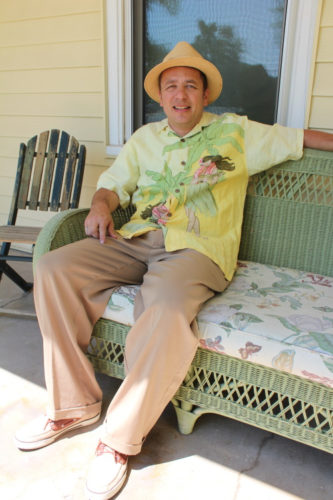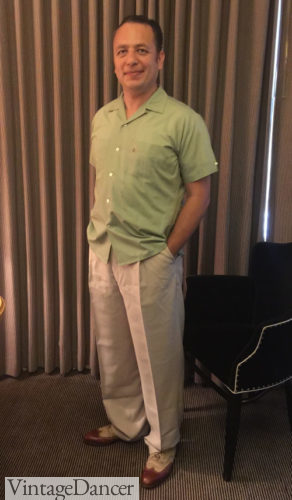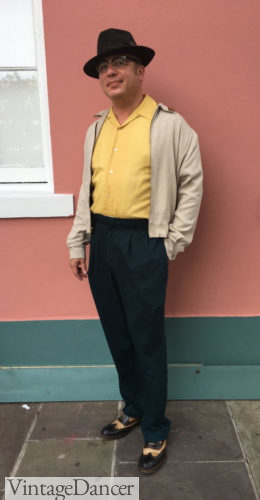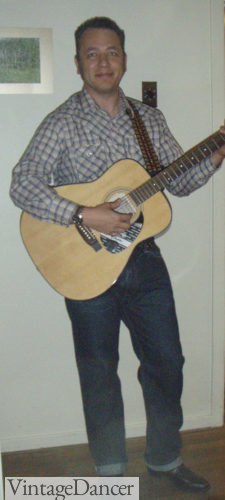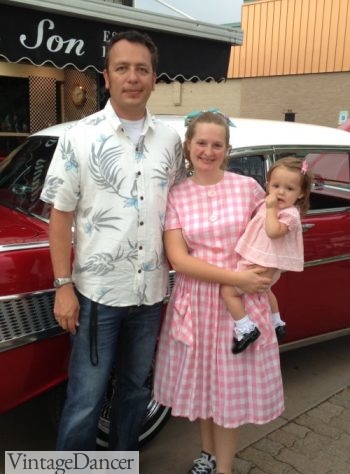With their big bodies and bigger styling, it’s no wonder that cars of the 1950s are seen as the cream of the crop among car clubs and enthusiasts. Events like Cruisin’ the Coast, The Texas Hoedown, Back to the 50s, and Hot August Nights see and celebrate a variety of classic cars, often attracting thousands of 1950s cars.
Since many of these car shows are just around the corner, it’s worth catching up on the general history of 1950s car culture in America… And for those attending in their own ’50s cars, nothing can elevate the presentation of a restored T-Bird, Chevy, or C1 Corvette more than dressing like you just rolled out from 1957.
Read on for general 1950s car culture history and some easy, historically accurate men’s 1950s costumes.
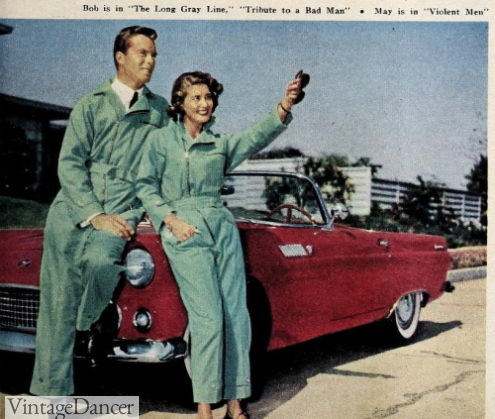
1955 Bob Francis and May Wynn pose in Coveralls they called “Motoralls”
1950s Car Culture and History
When you think “classic cars,” odds are you think ’50s cars, and for good reason. Not only were cars a key point of 1950s social culture and politics, but it was a decade of massive development across the US — all done with cars in mind.
Once again there was a big move towards suburbanization. This time, there were also drive-ins, drive-thrus, billboards, and malls.
Convenience in commuting became essential in the development of cityscapes. And then, something even bigger: the planning of a freeway system that would connect every American city with a population above 50,000. Officiated in mid-1956, Eisenhower’s Interstate Highway System was born in the 1950s.
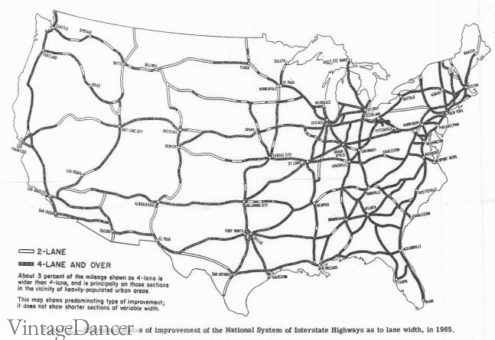
1955 Projection of the American Interstate System by 1965
History: Who owned Cars in the 1950s?
Less than 40 years ago, Henry Ford had a dream that any man with a good job could own an automobile. That dream just about came true in the 1950s. Cars were accessible to a point that is almost difficult to put into picture.
Not only were cars sold at dealerships, but in the early years of the decade you could find cars for sale at your local hardware store or even Sears. The auto industry blossomed and so did the workforce, with one in six working Americans employed in the auto industry by the end of the decade.
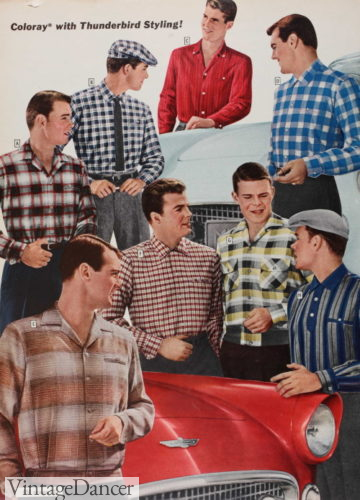
1956 Thunderbird inspired colors for these men’s shirts
Cars were rapidly becoming a necessary part of life. New 1950s suburbs meant driving in to the city for work and out to nearby malls (then flourishing as the new center of the community) on the weekends.
With the purchasing power of the 1950s middle class, some households were even able to support two cars — either one for each spouse, or a family car and a weekend car.
By 1958, the number of cars rose to around one for every three Americans… or 1.3 cars per U.S. household, or over 67 million cars on the road. Compared to the 25 million automobiles registered in 1950 (with less than one per household), it was a veritable explosion.
Domestic cars remained the norm in the United States, but the 1950s was the first decade where more cars were imported than exported. For those who could not afford a new Ford or Chrysler, there were cheap imports from Germany, Italy, and England. Used car lots were also growing in popularity as well as influence, becoming more reliable and accessible to the American public.
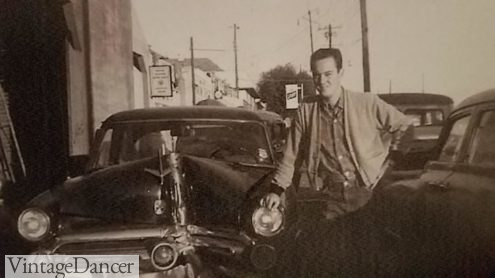
My Grandfather with his Wrecked 52-53 Ford Sedan (Mid 50s?)
The American relationship with 1950s cars was double-edged, however. On one hand, cars represented the pinnacle of the American Dream: freedom, independence, and opportunity.
On the other hand, for many they were a status symbol that pressured many in the middle class to compete. 1950s auto manufacturers often made models different from year to year to make past models visibly outdated. Keeping up appearances as a businessman or advertiser meant trading in for a new car at least every two years.
Even for those who weren’t as “fashion conscious,” a 1950s car with over 90,000 miles on it was rarely seen outside the back of a used car lot or the junkyard. Longevity wise, 1950s cars didn’t often make it past the seven-year mark.
Easy 1950s Costume Ideas for a Classic Car Show
So what would a 1950s car owners wear?
Cars were no longer exclusive to the wealthier classes. Paired with the trend towards comfortable and casual in 1950s men’s fashion, he could wear anything from a Mad Men-esque 1950s suit to the more casual rockabilly-esque wear. This article breaks down five costume ideas using five different general car body-styles/purposes.
The Hot Rod – Rock n’ Roll Teen
The era of pony cars and muscle cars was still a decade away, emerging around the early-mid 1960s. Young men of the 1950s with a need for speed (and four wheels rather than two) drove souped up cars, typically older cars ranging from 1930s jalopies to more recent 2-5 year old models. These vehicles were easily tuned and modified thanks to the new aftermarket parts businesses.
Performance and maintenance parts could now be purchased through third-parties instead of just from the manufacturer, which allowed for not only the upkeep of out-of-production cars but also affordable engine swaps, rebuilds, car care, and tuning. Hot rods reached their peak in the 1950s, with the formation of countless hot rod magazines, publications, and groups across the country.
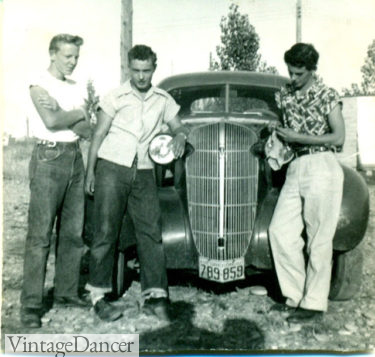
Late 1950s teenagers and their car
Due to the accessibility cheap cars, the ease of making those cheap cars fast, and a plethora of open lots and roads, drag racing and street racing became popular among 1950s youth.
First popularized on the West Coast, films like Rebel Without a Cause (1955) sent its popularity skyrocketing into and through the ’50s, with dangerous results. Many local laws would emerge banning it, and by the end of the decade it would be primarily an underground activity.
Note: 50s Hot Rods from Non-50s Cars
Many, possibly even most hot rods of the 1950s weren’t built from new model cars. Instead, prewar cars were preferred among hobbyists and shop classes for their low cost and low value.
If you own a ’30s hot rod, odds are it was made in the ’50s or later. It’s sometimes easy to identify if the hot rod was a product of the ’50s, but if it can’t be determined, I recommend dressing 1950s regardless.
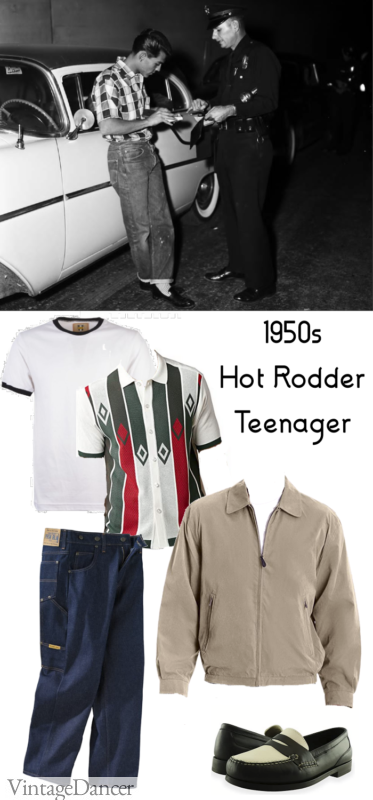
How To: This costume is ideal for a wide range of vehicles, from old sedans to hot rods of any caliber. For best results with a ’50s car, it’s best to look a few years ahead of the model year. If you’re driving a ’52 Ford, you can still wear slimmer cut pants and the like. This article on 1950s teen clothing is great for a more in-depth look at 1950s teens by year. And this article on the history of the Greaser look.
The foundation of this costume involves a pair of dark (or worn) denim jeans (with the cuffs rolled) and either a patterned button-up or crew-neck shirt, worn tucked into the pants. A belt is optional. In cooler weather, a gab jacket or varsity jacket can be worn and even decorated on the back (think the T-Birds from Grease). Shoes should be saddle shoes or loafers. If you want to go the full mile, take a look at teen oriented and greaser hairstyles here.
The Sedan – Drive-In Theater Usher
Drive-ins were a popular spot for middle class families of the 1950s. While they were a relative rarity in the late 1940s (155), their numbers increased a staggering 2,680% in just four years (4,151 drive-ins in 1951). This number would continue to climb to a peak of almost 5,000 in the late 1950s, early 1960s.
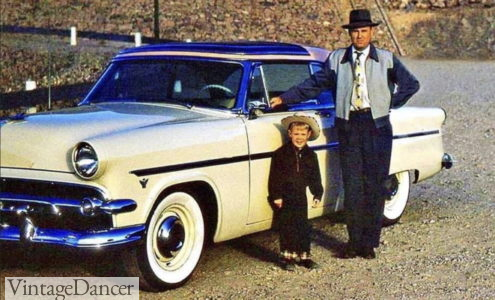
Kodachrome photo man, his car and child
In addition showing a movie, many drive-ins provided amenities such as food, petting zoos, live music, helicopter/hot air balloon rides, and even basic car services. With many charging per car as opposed to per-person, there was no better place to take the entire family… And no better car for the job than the family sedan. While you could dress like the standard 1950s man of the house, another option would be to don a drive-in usher’s uniform.
The great thing about this costume is that it’s great for any classic 1950s “family car” – sedans of any trim line from anywhere during the decade. The purchasing power of the 1950s middle class meant many comfortable families bought new cars. After all, a 1954 four-door Ford sedan retailed at only around $1800, or just under $20,000 today with inflation considered.

How To: The foundation (and really, almost all) of this costume involves finding a visible jumpsuit. White and khaki are OK colors to pick, but I recommend looking for a two tone like yellow and blue, red and white, or light blue and orange. Avoid hi-vis yellow/orange. The one I used in the picture is from Freddies of Pinewood. You can also buy a solid canary yellow, light blue, or red jumpsuit and add your own color trim for a much cooler effect. If you’re adding your own two-tone trim, consider using your accent color on the following:
- Full sleeves
- Stripe down Sleeves
- Stripe down Legs
- “Belt” on waist
- Collar
- Back panel
… or whatever else you can imagine!
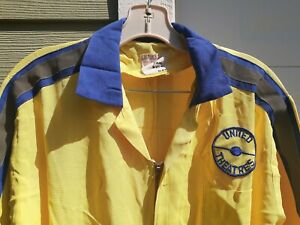
To complete the costume, vintage drive-in theatre patches can sometimes be found on eBay. You can also make your own custom embroidered patch for $10-$30 or simply get a generic “drive in” patch. The back of your jumpsuit can be finished with a custom iron-on decal if desired. Aside from that, all you need is a pair of black boots. Vintage drive-in accessories like a retro box of popcorn or a drive-in speaker installed in the car can go a long way for the costume.
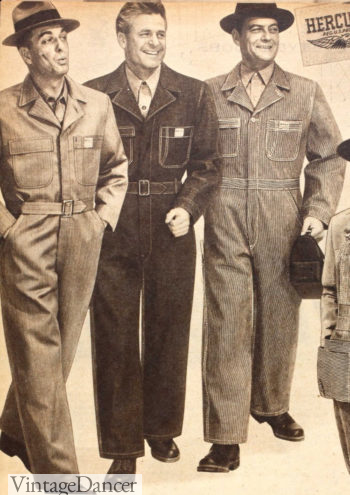
1956 coveralls
The Roadster – Hollywood Star
The 1950s was an era of beautiful roadsters and sports cars. Advanced technology allowed for faster cars with more luxurious amenities, all in unique body styles. Reasonably priced sports cars like the Triumph TR2/TR3 could be had for a few hundred dollars above the average car cost, while high-end 1950s European sports cars were owned mainly by the rich and famous.
While the Chevrolet Corvette was the quintessential American sports car and rightfully iconic, it was imported British and Italian vehicles that dominated the market of luxury sports cars. The avant-garde and clean-lined Euro style became a desirable aesthetic among the more socially forward of the time — a premonition of the beat and mod styles of the later ’50s and 1960s respectively.
Celebrities and stars of (especially the mid-late) 1950s wore clothes made with comfort in mind. As such, this costume is simple and casual, with clothes that can easily be worn elsewhere as well.
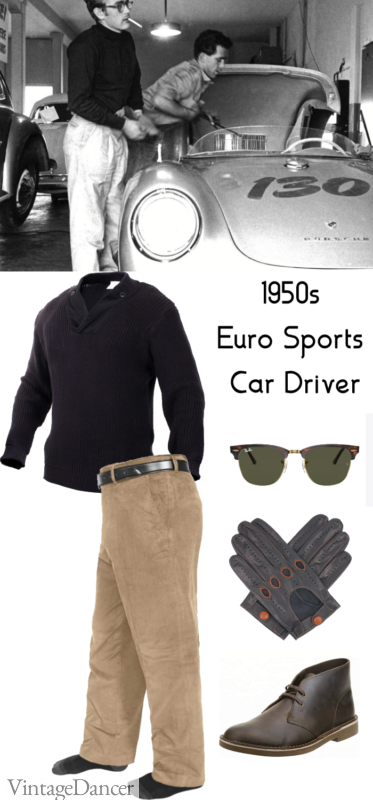
How To: 1950s upper class casual clothing was no-frills with a clean silhouette. For brightly colored cars, I recommend sticking to blacks, whites, and greys. Monochrome cars will do best with an accent of khaki/camel, blue, or red. I recommend a turtleneck/cowl neck sweater or (if warm) short-sleeved button-up shirt in a solid color. Pants should be loose and high waisted, in a lighter color such as khaki or cream. Complete with driving gloves, some sunglasses, and a pair of brown Oxfords or chukka boots. This costume does have a bit of a sixties flair, which makes it better for the mid-late 1950s. Keep the pants waist high and the leg wide to avoid looking too mod.
In very cool climates, a sport coat can be worn. I advise choosing a darker earth tone (like forest green) with elbow patches.
The Wagon – Family Vacationer
In the 1950s, wagons were a richer man’s car. Some models sold for double, sometimes triple the cost of a standard economy sedan – not to mention how absolutely massive and gas-guzzling they were. While woodie wagons of the 1940s were a luxury afforded by few, the ’50s marked an era of newfound desire for wagons, raising demand for these low-production vehicles.
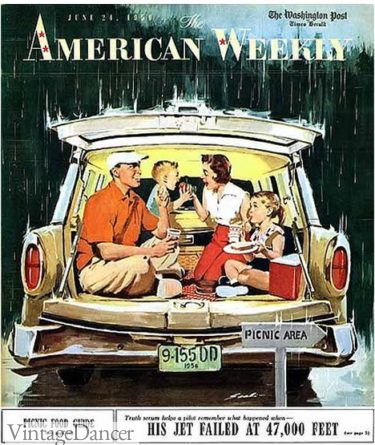
1956 car camping in a station wagon
1950s station wagons seemed to be primarily owned by suburbanites and ranchers, both groups of people who could park them off-street and pay the gas needs of a >12mpg vehicle.
Because of their large size, a lot of enthusiast publications and wagon-oriented literature involved how to convert the cars into impromptu RVs for a family road trip along the growing highway/turnpike system.
Seeing how dude ranches were the hit vacation spot of the 1950s, this costume pulls from 20th century westernwear and men’s 1950s casual clothing.
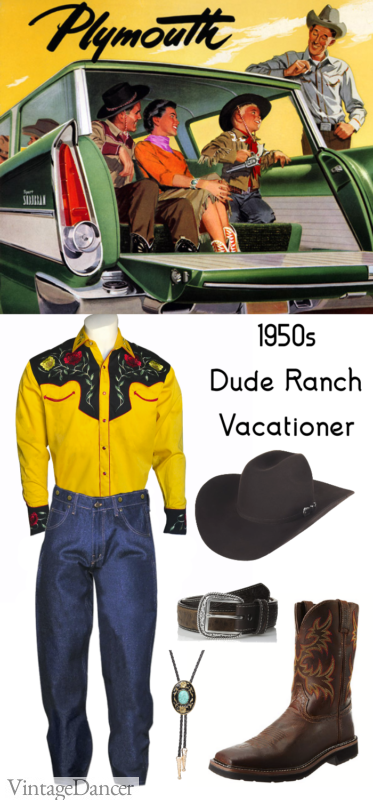
How To: The best thing about westernwear is that it has remained largely unchanged for nearly the past century. Provided you keep it loose (avoid slim fits), it takes little to make your outfit look fifties. My advice is to seek one of the “kitschy” western shirts, like these embroidered Rockmount ranch shirts. Wear it tucked. Your pants can be high waisted denim or dark khaki riding pants with a western belt. Complete with some western boots (pant legs worn inside), a bolo tie, and a cowboy hat for the brave.
For a less costume-ish and more ‘working man’ appearance, wear a simple plaid or contrast-stitched chambray shirt, worn with the top button undone and a T-shirt underneath. Keep the bolo tie, and if desired, wear the pants over your boots.
The Performance Car – Pit Crew
Perhaps you have a more fine tuned machine, one that ran a few circuits back in the days. With the rapid development of the SCCA and NASCAR and other racing groups throughout the 1950s, this isn’t unlikely. Hobbyist and professional race cars were a big thing in the 1950s, and many cars came out of the decade beautifully preserved with some great stories behind them.
While the racing scene was rapidly standardizing throughout the decade (like it had been doing in the 1940s), even professional circuits like NASCAR still had an amateur flair to them in its uniforms and methods.
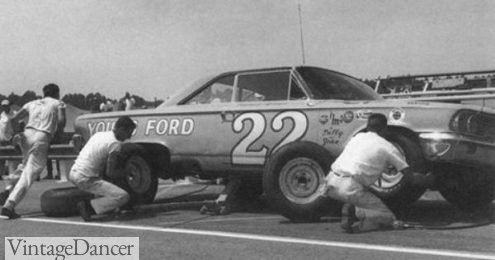
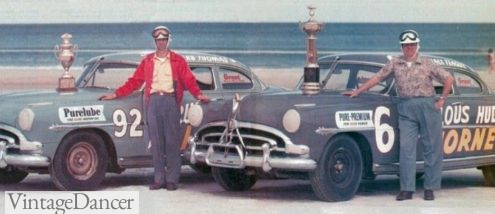
How can you tell a hot rod from a race car? Generally, hot rods choose aesthetic first and performance later. Race and performance car owners chose vehicles that were already quick and responsive for their competition racing. The Hudson Hornet, Thunderbird, and Corvette were especially well regarded.
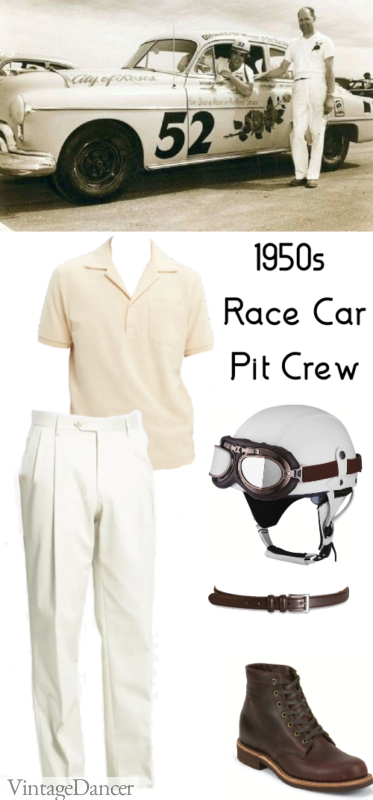
How To: The most recognizable racing/pit crew costumes are a solid white, typically two-piece for this decade. A white polo shirt and white slacks with brown shoes work for a race car driver and pit crew costume. If desired, you can add a racing team name/logo to your polo, but it’s just as good on its own.
Without an accepted or mandatory uniform in most racing groups and competitions, many men wore more casual or distinct attire. Whatever you choose, you’ll want a white half helmet with some leather goggles to complete the look.
More Accurate 1950s Men’s Costume Ideas
Another article of 1950s men’s costume ideas can be found here.
The history of men’s 1950s businesswear can be found here along with our article dedicated to 1950s men’s casual clothing and men’s 1950s vintage workwear.
Shop all 1950s men’s clothing and view our full article list here.
- Hawaiian Hula Girl Linen Shirt
- Genuine Vintage from Head to Toe
- Swanky’s Vintage Jacket and Pants. Vintage Shirt and Shoes. New Fedora Hat.
- Plaid Western Shirt, Dark Blue Jeans with a Roll Cuff, and Black Boots
- Vintage 1950s Businessman
